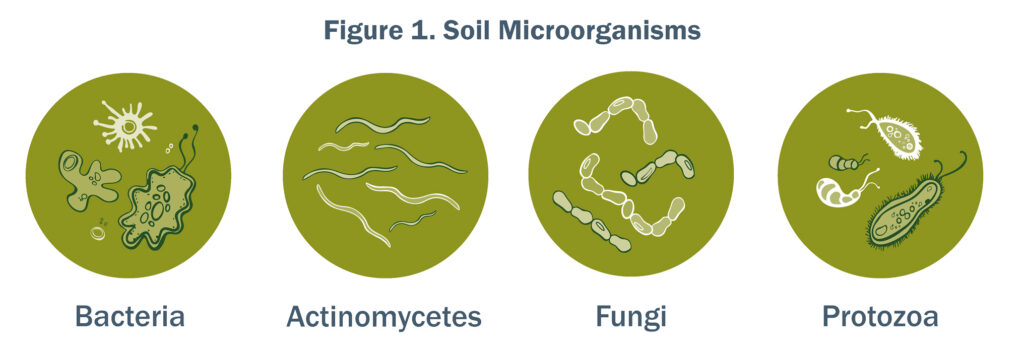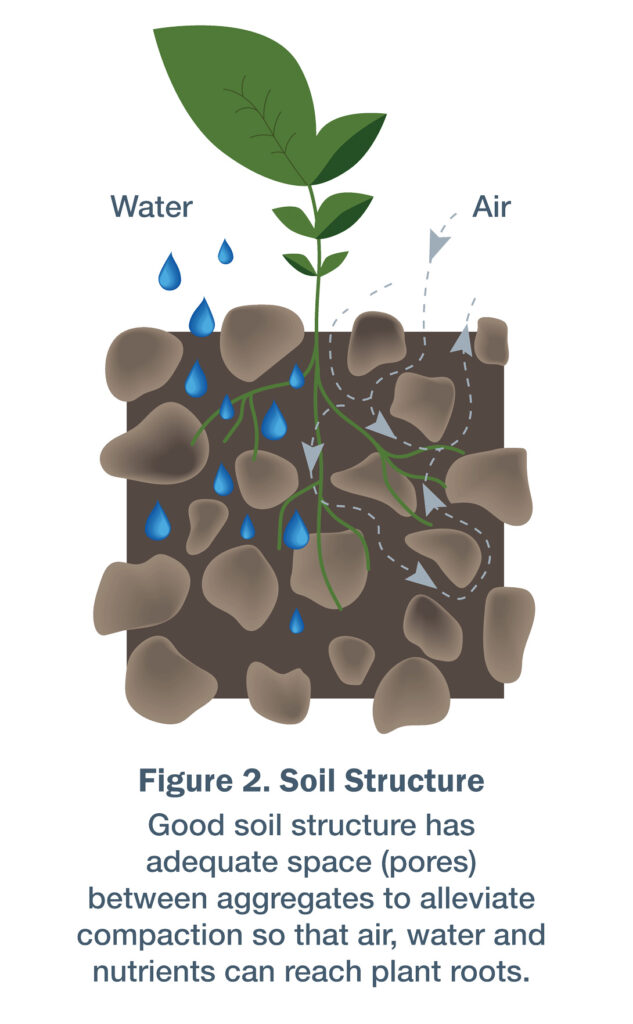Soil is a living environment and is made up of an incredibly complex mixture of mineral particles, nutrients, organic matter, water, air, and a diverse assortment of living organisms.
After decades of farming, we have seen the decline in nutrient availability, fertility, and crop production. To ensure sustainability in agriculture for the years ahead, more focus should be placed on achieving ecological and economic soil regeneration through restoring the nutritional, biological and structural components of soil fertility. The nutritional (chemistry) and structural (physical) aspects are widely understood, however, although improving, it is the biological side that is often overlooked and not recognised as sometimes being the limiting factor of a crop, pasture or even your livestock not yielding or performing. While worms, beetles and other insects are more obvious, 80-90% of the biological activity in your soil is carried out by the diversified array of microorganisms including bacteria, fungi and other microbes. Like the weakest link in a chain, if this one aspect of soil fertility is ignored, the whole system of soil management is compromised.
THE “UNSEEN WORKERS”
The importance of microbial activity can often be underestimated, and the link within the soil ecosystem
misunderstood. There are many species of micro-organisms, including Bacteria, Actinomycetes, Fungi, and Protozoa (Figure 1) and each has their own benefits.

Soil organisms are essential for soil health and economic crop production. Their central role is to convert organic matter derived from decaying plant and animal material and mineral elements into available forms for plants and other organisms to absorb. Soil microbes operate in a multifaceted manner to
assist:
SOIL STRUCTURE, EROSION, WATER PENETRATION
The physical activity of worms, insects, and arthropods create large and small pores in the soil profile. These pores allow air and water to move freely through the soil, giving effective water infiltration as well as drainage (highlighted in Figure 2). Bacteria and fungi excrete polysaccharide (mucus like compounds) that bind soil particles together. Many soil fungi possess root like structures known as hyphae, and this thread like network of structures help to bind soil particles together to improve stability and structure.
INCREASE NUTRIENT AVAILABILITY
Earthworm and micro-organism castings and residuals contain increased amounts of plant nutrients. Dr. Wes Jackson (USA) has found that when compared to soil devoid of life, soil worked by microorganisms and earthworms has shown significant increase in nutrient levels, including the following:
- Nitrate increase 500%
- Available Phosphorus 700%
- Exchangeable Potassium 1200%
- Exchangeable Calcium 150%
- Organic Carbon 200%.

Many plants form intimate and symbiotic relationships with bacteria and fungi in order to increase uptake of specific elements. Obvious examples include Rhizobium bacteria with legumes for increased Nitrogen, and Mycorrhizal fungi (VAM) which releases locked up phosphorus and other nutrients from the soil environment. These microbes are naturally occurring in healthy soil.
NEUTRALIZING PH IN BOTH ALKALINE AND ACID SOIL
Good levels of humus in your soil provides a reservoir for mineral nutrients and can hold up to 200kg of Nitrogen per hectare. Microbe activity will help to neutralise the pH in both acid and alkaline soil. Under optimum conditions, these microbes can produce their own weight in pH neutral humus everyday.
NUTRIENT AND MOISTURE HOLDING CAPACITY
As well as being a reservoir for nutrients, humus provides a storehouse for water… helping to drought proof your farm. Organic Carbon is an indication of humus levels and the higher the level – the greater moisture holding capacity in your soil.
SUPPRESSING, AND PREVENTING DISEASE
Soils with high levels of organic matter and microbe activity can prevent more aggressive plant diseases
from taking hold by suppressing and/or feeding on the pathogens.
ACT AS BIO-FILTERS TO CLEAN UP POLLUTANTS IN YOUR SOIL
LONG TERM PRODUCTIVITY
Micro-organisms and earth worms produce the most nutritionally charged soils in the world, leading to increased productivity and profitability without the need for additional fertiliser applications and tillage.

There are an estimated 60,000 different species of bacteria alone numbering in their billions per gram of soil.
THE DEPLETION OF LIFE IN THE SOIL – MICROBE & WORM ACTIVITY
The number, variety of species, and activity of soil organisms will vary dependent on the soil environment. Soil organisms thrive in natural and healthy soil, where the biomass of microbes can easily amount to 4 or 5 tonne per hectare. Unfortunately, due to declining soil fertility, increasing use of high analysis fertilisers, crop protectants and tillage, populations of soil organisms are
depleting.
CSIRO research has found that 80kg/ha of Nitrogen fertiliser can reduce soil microbe populations by 25% and that high Phosphorus inputs reduce the beneficial effects of mycorrhizae fungi. In addition, the use of high levels of fertilizer can reduce humus levels in your soil – for every 1kg of excess Nitrogen applied, 100kg of soil humus is destroyed. Natural factors including hot and dry weather, cold conditions and excessive rain can also contribute to depleted microbe populations.
HOW TO PROTECT, NOURISH AND STIMULATE YOUR SOIL’S MICROORGANISMS
Soil fertility is dependent on microbes and the best way to replenish microbes in your soil is to stimulate
and support the diverse range of naturally occurring microbes that are already present. The key to ‘farming microbes’ is to provide a balanced environment for their function and survival. Minerals, mulch, moisture, and air are the essential ingredients in your soil to enable these microbes to thrive.
MINERALS
Decades of intensive farming is gradually exhausting mineral elements available in the soil. Incorporating a broad-spectrum mineral and trace element fertiliser and soil conditioner into your soil management program can help restore the mineral balance in the soil. Soil remineralisation is a key factor to restore natural fertility to your soil.
MULCH
Mulch provides a home for soil organisms. It is converted into the carbon faction of humus by soil
microbes. A green manure crop provides the best supply; however plant roots and stubble also provide a valuable source of mulch.
MOISTURE
When confronted with hostile conditions such as lack of moisture or toxic conditions, micro-organisms
such as bacteria retreat to a spore form (a type of hibernation), and worm activity has a similar “hibernation” habit.
AIR
The level of soil aeration and changes to aeration can greatly impact the species and population of the microbial community. Although some microorganisms can survive in flooded or compacted soils,
most require a substantial supply of oxygen.
Undertaking a soil test every two to four years or after an unusual event such as drought or flooding can identify underlying nutritional issues, provide insight into your soil health, along with a good indication of actions required to address imbalances or deficiencies. A soil test also provides a reference point to measure soil regeneration progress.
NATRAMIN – THE KEY TO SOIL FERTILITY
Soil fertility is dependent on microbes and the best way to replenish microbes in your soil is to stimulate
and support the diverse range of naturally occurring microbes that are already there.
NatraMin contains an array of broad spectrum of mineral and trace elements and contains a specifically formulated bio-stimulant to enhance both microbe and worm activity in your soil. When used in a soil management program that also address additional factors such as organic matter and aeration, NatraMin can assist in creating this environment for increased biological fertility in your soil.
“The soil microbes increase nutrient availability for the plant. Our focus is to cut back on our chemical use and when we have to use something that is detrimental to soil health, we apply things like humic or fulvic acid and products like NatraMin to offset the impact on the ‘good guys’ in the soil. We’re more comfortable farming this way. Our soil is our biggest asset and soil health in agriculture has declined, so we’re working with nature as much as we can to turn it around.” -Geoff Brown, Quirindi NSW
